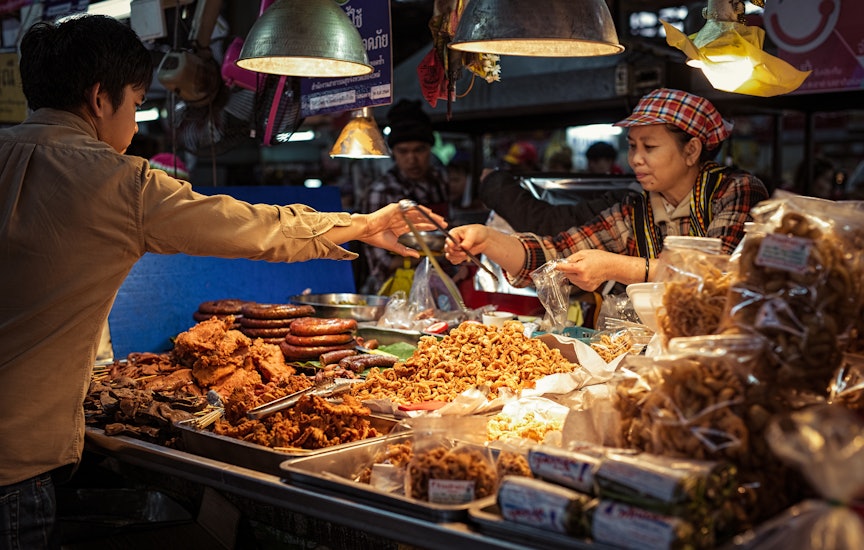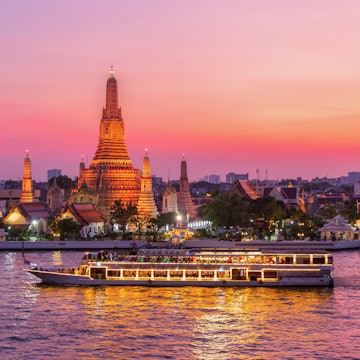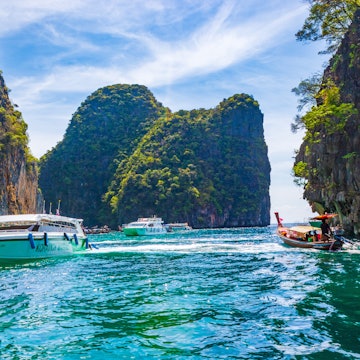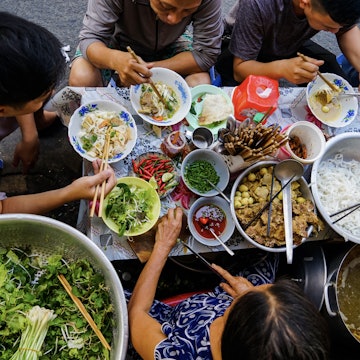

Yes, you really can get around Bangkok by long-tail boat. Some of it, anyway. ©splendens/Getty Images
With a population of more than 11 million, greater Bangkok is a sprawling metropolis that can be traversed by taxi (car and motorcycle), túk-túk, bus and boat. So there is always a way to move around, but a little savvy will go along way to help you get from A to B safely and efficiently – the rules of the road tend to be suggestions, and sidewalks are an inconsistent presence (and sometimes even impromptu motorcycle roadways).
A major transport highlight is the ever-expanding light-rail mass transit system. Even old-timers familiar with the original two central city Skytrain lines will be surprised to learn that there are now 10 lines with a total of 181 stations and more to come. Lines cross the Chao Phraya River and reach far into the northern and southeastern suburbs.
Here are our tips for navigating this energetic behemoth of a city by road, rail and river.
Explore far and wide on the sleek Skytrain and MRT trains
Somewhat simplified, Bangkok has two commuter light-rail systems: the Skytrain and MRT (Mass Rapid Transit). One-way fares start at 16B and go up to 59B. Visitors should be aware that transferring between stations of the two systems usually entails a walk of at least several hundred meters. A prime example is the long walk between the Skytrain’s Sukhumvit station and the MRT’s Asoke station at the intersection of Thanon Sukhumvit and Thanon Asoke/Sukhumvit Soi 21 near Terminal 21 mall.
More important, the systems have separate payment systems. In fact, the MRT consists of several systems because it fields three different operators. While it's relatively easy to move between the old and new MRT lines, you will have to buy a new token when transferring to the new Pink, Purple and Yellow lines.
The MRT is the more extensive network with six lines and 120 stations and counting. In central Bangkok, the trains of the original Blue Line run underground north from Asoke intersection before looping westward to intersect with the Skytrain's light green Sukhumvit Line near Chatuchak Park and crossing the river.
Outer stations and the five newer MRT lines run high above ground like the Skytrain. With the opening of the Sanam Chai station, one of the newest stations on the Blue Line's western lower leg, there is finally a station on Ratanakosin Island. It’s midway between Chinatown and the Grand Palace.

Ride the Skytrain to Thonburi's shopping attractions
The Skytrain, the original two-line elevated commuter rail system debuting back in December 1999, is officially known as the Bangkok Mass Transit System or "BTS." In practice, "BTS" has become a common nickname for all the commuter lines. If you're desperately looking for the nearest Skytrain or MRT station, asking a Thai passerby or taxi driver for the nearest BTS station ("sà·tăh·nee BTS"), will get you directions.
Although it's added stations (for a total of 60) in the past two decades, the Skytrain remains a two-line system. What about that BTS Gold Line west of the river in Thonburi? The vehicles aren't actually trains but ground-level "people movers" similar to the shuttle trains that run between terminals of very large airports. Costing a flat 15B fare, this three-station line starts near the Skytrain's Krung Thon Buri station. With a stop at the luxury Iconsiam shopping mall, it runs parallel to Thanon Charoen Nakhon and its growing array of hipster cafes and artsy shops.
Enjoy the breeze on a riverboat "bus"
The more pleasant way to visit Thonburi from Bangkok is simply to catch one of the flat raft-like ferries that chug from bank to bank from dawn to dusk. Departing from 32 piers (tha), the one-way fare is a mere 3.5B (or 4B from the Wat Pho pier). Many of the large hotels on both sides of the river operate their own sturdier shuttles across the river for free.
Large piers are also stops for the large longtail Chao Phraya River boats that run up and down the river like public buses with scheduled stops. To the south, the boats start in Samut Prakan province and travel all the way up to the town of Nonthaburi in the north. The piers dotting the old royal city of Ratanakosin Island are Tha Tien, Tha Maharaj, Tha Prachan and Tha Phra Athit/Banglamphu. The Skytrain's Saphan Taksin station is close to Tha Sathorn.
With most boats beginning trips around 6am and ending around 7:30pm, the inexpensive fares start at 10B and run up to 40B, depending on distance and type of boat. Pay close attention to the color of the flags: they indicate whether a boat stops at every pier or is an express stopping at only select piers. The blue-flagged boat is a tourist boat that will stop at piers chosen by passengers.

Catch a longtail boat on the Saen Saep Canal
There’s no more enjoyable way to get a sense of the traditional Thai life than to spend a day on a longtail boat exploring the canals (khlong) of Thonburi. But if you want to get around Bangkok by longtail, there are only the commuter boats running along the Saen Saep Canal (khlong saen saep). In the west, the route starts on the southeast edge of Ratanakosin Island near the Golden Mount Temple. The canal slices eastward 18km all the way to Minburi district.
The ride offers plenty of colorful sights and the smells of canal-side living. Passengers need to be nimble as the narrow longtail stops for only moments at a pier before speeding on to the next. For visitors, the most common route is between the Golden Mount and the pier at Hua Chang Bridge that crosses Thanon Phayathai near the Ratchathewi Skytrain station. Jim Thompson's House is a five-minute walk from this pier. It's a ten-minute walk to Siam Square, MBK mall and the Bangkok Arts and Culture Centre. The next pier stop is at Pratunaam, which is walking distance to the garment outlets and Ratchaprasong intersection.
Collected on board by conductors with a very good sense of balance, fares run from 8B to 20B, depending on distance. On weekdays, the first trip starts at 5:30am; the last finishes around 8:30 pm. On weekends, the first is 6am and the last finishes at 7pm.
For more information on navigating Bangkok's waterways, check out this article.
Flag down (a very affordable) taxi
All taxis in Bangkok are metered and air-conditioned. A small electric sign in the taxi's front window will flash red or green; it's free if the sign is red. Make sure the driver starts the meter. If the driver asks if it's your first time in Thailand and it is, say no and you shouldn't have any problems. Rigged meters are very, very rare.
Fares start at 35B and go up with time and distance. Expressway fares and a long wait in Bangkok's notorious traffic jams will jack up the fare a bit, but the 36km (22mi) from Suvarnabhumi Airport to the riverside hotels along Charoen Krung Road, for example, will still cost less than 300B. You will pay expressway fees (30B to 70B) as you travel.
The vast majority of Thai taxi drivers are amiable and honest, and they'll be happy to humor your efforts at the Thai language. Translation apps have made it easier than ever to communicate. Drivers often work 12 hours a day, six or seven days a week, for little profit. While it's not required, a tip of even 20B is appreciated.
Three ride-hailing apps operate in Thailand: Grab, Bolt and inDrive. While an app will let you know the fare ahead of time, you’ll probably pay more than if you flag down a passing taxi. As elsewhere in the region, drivers dislike hailing apps' impact on the local transport industry. There are so many taxis circulating in most parts of Bangkok – before you open a hailing app, look around to see if you can flag down a taxi on your own.

Try out a túk-túk or motorsai
Most tourists want to give a three-wheeled open-air túk-túk a whirl at least once but, unless you're very good at haggling, a trip will be more costly than one by taxi – drivers tend to open with a 100B bid. Túk-túk are useful, though, for hauling bulky purchases.
Ignore drivers who make promises of very cheap fares, tell you that an attraction such as Wat Pho is "closed today" or want to make a quick detour at a jewelry store: they're running a vintage scam. Near the túk-túk lined up outside large markets like Big C, there will often be a board posted in both Thai and English with set fares to common destinations.
The drivers of motorcycle taxis (motorsai) have similar boards set up near popular bus stops and commuter train exits such as Chatuchak Park and the Airport Rail Link's terminus. Otherwise, you need to haggle with the orange-vested drivers who cluster around busy intersections. If you know the words for numbers in Thai, you can probably shave off 20B to 50B. Ask the driver to lend you a helmet.
Getting from and to Suvarnabhumi Airport
Operating from 6am to midnight, the 28km-long Airport Rail Link is the swiftest and least stressful way to travel to and from Bangkok's principal airport. The eight-station train runs westward from the airport's basement level, where there are machines for changing paper currency and purchasing tokens with coins. The fare ranges from 15B to 45B, depending on destination. Get off at Rail Link’s Hua Mak station to switch to the MRT system’s own Hua Mark station; get off at Makkasan station to transfer to the MRT's Phetchaburi station. The Skytrain can be accessed from Phaya Thai station, the Rail Link's final destination. Note that the Airport Link, Skytrain and MRT each have their own payment system.
A non-stop shuttle bus runs in both directions between Suvarnabhumi and Don Mueang airports from 5am to midnight. It's free but you need to show your onward ticket.
Getting from and to Don Mueang Airport
The good news is that an MRT station now serves Don Mueang Airport, the hub for budget airlines flying domestic and short-haul international routes. The bad news is that the Dark Red Line's Don Mueang station probably won't be of any use to you, unless you're heading to or from Krung Thep Aphiwat, the enormous new central inter-city railway station in the Bang Sue neighborhood.
For many more travelers, the cheapest and most convenient option is one of four air-conditioned shuttle buses running into the city. Their stops are clearly marked just outside the airport doors. Collected on board, the fare runs from 30B to 50B. Operating daily from 7:30am to midnight, both A1 and A2 shuttles have stops near Chatuchak Park, where passengers can access either the Skytrain's Mo Chit station or the MRT's Chatuchak station. A3's stops include Pratunaam and Lumphini Park. Operating from 7am to 10 pm, the A4 terminates at Sanam Luang and Khao San Road.
On the ground level of both domestic and international terminals is a “Limo Bus” desk. The Airport Limo Bus Express will take you directly to Khao San Road. At 150B, it’s more expensive than the A4 shuttle, but is more comfortable, offers Wifi and has fewer stops.

Get to your hotel safely using the Bangkok airports' public taxi system
Whether you arrive late at night or just want a hassle-free path to your hotel, both Suvaranabhumi and Don Mueang airports have organized a safe system for matching passengers with public taxi drivers.
At Suvarnabhumi Airport, go to Level 1, which is the ground and arrivals level. At Don Mueang, go to the ground floor. At both airports, look for the metered taxi desk inside a roped-off seating area. Get a ticket from the queue machine. Although many people may be ahead of you, the process moves quickly. When your number comes up, the clerk will ask your destination and give you a numbered ticket. Hold onto it. If you later have a complaint, the desk has a record of the taxi you were assigned.
Outdoors, you will be matched up with a taxi and the driver informed of your destination. Make sure he starts the meter. All the drivers have been certified by the Airports authority. In return, you pay the driver a 50B surcharge in addition to your fare and the tolls (50B and 70B) if you choose the expressway,
Accessible transportation
Bangkok is certainly an obstacle course for the mobility impaired – expect broken sidewalks and very few ramps and curb cuts. The shining exception is the light-rail system. Immediately inside the sliding doors of the trains of the Airport Railway Link, Skytrain and MRT are four seats designated as a priority for the disabled, elderly and pregnant women.
Elevators link the levels of Suvarnabhumi Airport to the basement and the Airport Railway Link. But the trains themselves can only be accessed by manual wheelchairs. As with the other two train systems, station attendants are happy to assist the blind and those in wheelchairs.
All of the MRT trains can be accessed by pairs of elevators: the first elevator goes from the outdoor road level to the payments and turnstile platform; the second from that platform up to the train level. However, five MRT stations have a major drawback: the outdoor elevator is only on one side of the road. These stations are Lat Prao, Ratachadapisek, Sutthisan, Huai Kwang and Thailand Cultural Centre.
Among the Skytrain stations, only thirteen have full elevator (and thus wheelchair) access. They are Asoke, Ang Chai, Bang Na, Bearing, Chong Nonsi, Krung thon Buri, Mo Chit; On Nut; Pho Nimit; Punnawithi; Talat Phlu, Udom Suk, Wong Wian Yai and Wutthakat.
Keep planning your trip to Bangkok:
Revel in Bangkok's excellent food scene with Local Bites: the best places to eat and drink in Bangkok
Discover fun for the whole family with Your ultimate guide to visiting Bangkok with kids
Wander further afield with The best day trips to escape Bangkok's crowd
Create a budget-friendly itinerary with 23 free things to do in Bangkok to get more bang for your baht















